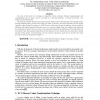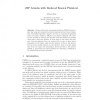53 search results - page 9 / 11 » On the (Im)Possibility of Key Dependent Encryption |
DIM
2005
ACM
13 years 9 months ago
2005
ACM
Mobile Location-Based Services (LBS) have raised privacy concerns amongst mobile phone users who may need to supply their identity and location information to untrustworthy third ...
CORR
2010
Springer
13 years 7 months ago
2010
Springer
Problem statement: This paper examines Artificial Spiking Neural Network (ASNN) which inter-connects group of artificial neurons that uses a mathematical model with the aid of blo...
IJACTAICIT
2010
13 years 4 months ago
2010
The aim of this work is to design an algorithm which combines between steganography and cryptography that can hide a text in an image in a way that prevents, as much as possible, ...
ICPR
2008
IEEE
14 years 8 months ago
2008
IEEE
Fuzzy vault has been shown to be an effective technique for securing fingerprint minutiae templates. Its security depends on the difficulty in identifying the set of genuine minut...
FSE
2001
Springer
13 years 12 months ago
2001
Springer
Abstract. Biham and Kocher demonstrated that the PKZIP stream cipher was weak and presented an attack requiring thirteen bytes of plaintext. The deflate algorithm “zippers” no...



